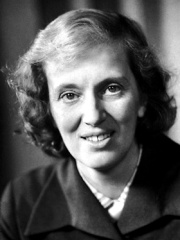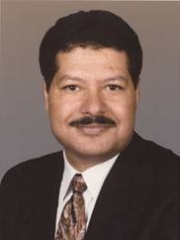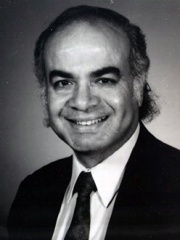


The Most Famous
CHEMISTS from Egypt
Top 3
The following people are considered by Pantheon to be the most legendary Egyptian Chemists of all time. This list of famous Egyptian Chemists is sorted by HPI (Historical Popularity Index), a metric that aggregates information on a biography's online popularity.

1. Dorothy Hodgkin (1910 - 1994)
With an HPI of 75.09, Dorothy Hodgkin is the most famous Egyptian Chemist. Her biography has been translated into 92 different languages on wikipedia.
Dorothy Mary Crowfoot Hodgkin (née Crowfoot; 12 May 1910 – 29 July 1994) was an English chemist who advanced the technique of X-ray crystallography to determine the structure of biomolecules, which became essential for structural biology. She received the 1964 Nobel Prize in Chemistry, and is the only British woman scientist to have been awarded a Nobel Prize. Among her most influential discoveries are the confirmation of the structure of penicillin as previously surmised by Edward Abraham and Ernst Boris Chain; and mapping the structure of vitamin B12, for which in 1964 she became the third woman to win the Nobel Prize in Chemistry. Hodgkin also elucidated the structure of insulin in 1969 after 35 years of work. Hodgkin used the name "Dorothy Crowfoot" until twelve years after marrying Thomas Lionel Hodgkin, when she began using "Dorothy Crowfoot Hodgkin". Hodgkin is referred to as "Dorothy Hodgkin" by the Royal Society (when referring to its sponsorship of the Dorothy Hodgkin fellowship), and by Somerville College. The National Archives of the United Kingdom refer to her as "Dorothy Mary Crowfoot Hodgkin".

2. Ahmed Zewail (1946 - 2016)
With an HPI of 68.82, Ahmed Zewail is the 2nd most famous Egyptian Chemist. His biography has been translated into 68 different languages.
Ahmed Hassan Zewail (February 26, 1946 – August 2, 2016) was an Egyptian-American chemist, known as the "father of femtochemistry". He was awarded the 1999 Nobel Prize in Chemistry for his work on femtochemistry and became the first Egyptian and Arab to win a Nobel Prize in a scientific field, and also the first African to win a Nobel Prize in Chemistry. He was a professor of chemistry and physics at the California Institute of Technology (Caltech), where he was the first Caltech faculty member to be named the Linus Pauling Chair of Chemical Physics and served as the director of the Physical Biology Center for Ultrafast Science and Technology.

3. Rashad Khalifa (1935 - 1990)
With an HPI of 60.38, Rashad Khalifa is the 3rd most famous Egyptian Chemist. His biography has been translated into 17 different languages.
Rashad Khalifa (Arabic: رشاد خليفة; November 19, 1935 – January 31, 1990) was an Egyptian-American biochemist, closely associated with the United Submitters International (USI), an organization that promotes the practice and study of "Quran, the Whole Quran, and Nothing But the Quran." Khalifa saw his role as purging the accretions that found their way into Islam via hadith and sunnah, which he claimed were corruptions. Similarly, he believed that previous revelations of God, such as the Bible, contained contradictions due to human interference (a concept known as tahrif). Instead, he believed that the beliefs and practices of Islam should be based on the Quran alone. He is also known for his claims regarding the existence of a Quran code, also known as The Number 19. In the last years of his life, Khalifa used the English words “Submission” and “Submitter” instead of the Arabic words ‘Islam’ and “Muslim”, and stated this in his publications and used it in his 1989 translation of the Qur'an.[1] His changing views regarding the essence of faith, recorded in his two renditions of the Quran, and declaring himself as a divine messenger who communicated with Gabriel, drew opposition from other Muslims. On January 31, 1990, Khalifa was found stabbed to death inside the Mosque of Tucson, in Arizona, which he founded.
People
Pantheon has 3 people classified as Egyptian chemists born between 1910 and 1946. Of these 3, none of them are still alive today. The most famous deceased Egyptian chemists include Dorothy Hodgkin, Ahmed Zewail, and Rashad Khalifa.
Deceased Egyptian Chemists
Go to all RankingsDorothy Hodgkin
1910 - 1994
HPI: 75.09
Ahmed Zewail
1946 - 2016
HPI: 68.82
Rashad Khalifa
1935 - 1990
HPI: 60.38
Overlapping Lives
Which Chemists were alive at the same time? This visualization shows the lifespans of the 3 most globally memorable Chemists since 1700.

